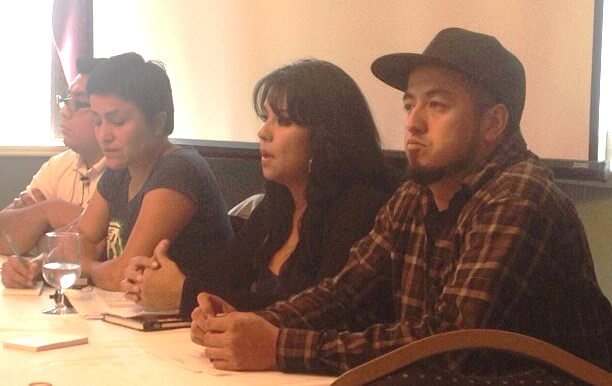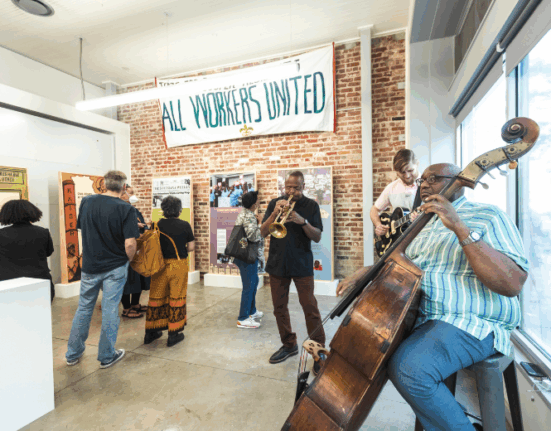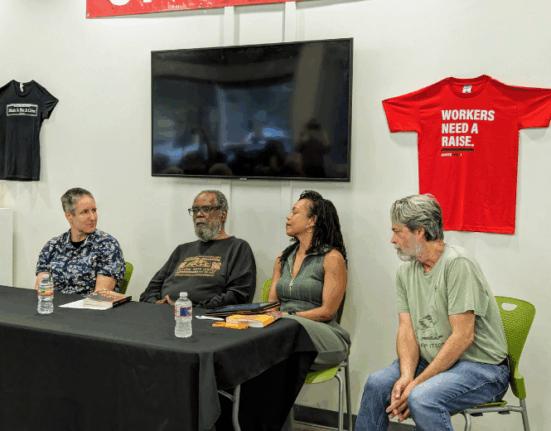I think a lot about the problems of building a labor movement for the 21st century. And, as a long-time labor activist who now finds himself a member of a worker-owned cooperative (I work at Webskillet Cooperative, which is both a worker coop and a UE union shop), I struggle with reconciling the militant traditions that have shaped my outlook with the sometimes overly optimistic approach of the cooperative movement.
On Saturday October 19 I drove down to Glens Falls, New York, for an international meeting of union cooperative workers. The newly-formed network of cooperative workers inside UE, which includes four worker coops and the organized workers at two food coops, was hosting a coop delegation from Mexico’s Frente Auténtico del Trabajo (FAT).
The UE and FAT have a long and deep relationship. Initially formed during the fight against NAFTA, when the “official,” government-controlled trade unions in Mexico supported the free trade agreement, the UE-FAT Strategic Organizing Alliance has included joint organizing projects targeting the same multinational employers, support for each others’ organizing — including the FAT organizing Mexican unions to file a complaint against the US for denying collective bargaining rights to public sector workers in North Carolina, and many, many exchanges of rank and file workers.
The UE’s semi-official slogan is “The Members Run This Union,” reflecting both a commitment to democracy and a belief that working-class people have the capacity to run their own unions. The FAT’s slogan, “¡Por la autogestión de la clase trabajadora!” doesn’t translate smoothly into English, but it means, roughly, “for the self-management of the working class” — reflecting a belief that working-class people have the capacity to run everything about their lives.
The FAT, unlike UE, is not solely a union (the name literally means “authentic workers’ front”). While the union sector is the largest, they have long had a cooperative sector. In large part, this stems from the fact that Mexican labor law, in some cases when an employer cannot pay the settlements they owe to the workers, allows workers to take over buildings and equipment and either sell them or run them cooperatively. However, it also reflects the FAT’s commitment to autogestión.
The FAT delegation we met with included the director of the FAT’s cooperative sector, a leader from a state workers’ union which is forming coops to help its members build their own green housing, the general accountant of a credit union which was formed by the FAT in the wake of a strike 26 years ago, and a member of Bicicooperativa Urbana, a coop of young bicyclists in Mexico City who are sort of an incubator for bicycle-based businesses in the city, including a parcel delivery service, bicycle repair and bicycle parking lots. This was the second UE-FAT exchange to focus on the cooperative sector, following a visit by UE coop members to Mexico in November of last year.

The cooperative movement and the labor movement, of course, emerge from a similar history of working-class organization. The modern coooperative movement generally traces its history to the Rochdale Pioneers, a group of weavers, Owenite socialists and other workers who started a cooperative grocery in 1844, in an area of England with a rich history of working-class agitation. Not unlike the FAT credit union, the Rochdale pioneers started their cooperative after an unsuccessful weavers’ strike.
In fact, the principles of cooperation, as an alternative vision to capitalism, animated the vision of the first large-scale labor movement in the US, the Knights of Labor. The Knights, along with many other radicals in the late nineteenth century, expressed their goal of an exploitation-free society as “The Cooperative Commonwealth.” The fact that they used this term rather than being explicitly socialist, as most European labor movements were, combined with the fact that some leader of the Knights expressed distaste for strikes (stating that workers should instead form cooperatives), has not done wonders for their reputation among labor historians, who tend to be a rather left-wing and pro-strike bunch.
I don’t think cooperatives are the answer to everything (my UE brothers and sisters currently fighting a GE plant closure in Ft. Edward, NY are not going to be able to take over and run that capacitor plant as a worker coop — but I think they do have a shot at convincing GE to keep the plant open). Nonetheless, I think the idea of the cooperative commonwealth, and of various forms of cooperative organization of social life, bears reexamining in a couple of ways:
1. I think we need more historical investigation of the Knights’ practical experience with cooperatives. Did they actually try to form cooperatives, and if so what kinds (worker, consumer, producer)? What challenges did they face, and how did they try to overcome them? What was the organizational role of cooperatives within the Knights’ assemblies (their form of local organization), and what relationship (if any) did they have to groups of workers who engaged in more traditional collective bargaining?
2. The labor movement, and the left more generally, has been on the defensive about the public sector. Partly this reflects ruling class strength, partly this reflects strategic weaknesses and mistakes on our part, but partly this also reflects the reality that for many people (especially, though not exclusively, poor and working-class people), dealing with the actually-existing public sector can be extremely frustrating. Racist teachers, unhelpful bureaucrats and condescending social-service providers are not the rule, but they are not uncommon either. While I think we absolutely need to close ranks to defend the public sector, and public-sector workers, we also need to think more creatively about ways to make the delivery of social goods more participatory and accountable to the people who are being served.
3. Finally, I think most people who care about such things realize that our currently-existing institutional labor movement (i.e., the trade unions) are at the very least not sufficient to defend the working class from the assaults of capital, let alone improve the condition of the working class and the people as a whole. In order to “join the labor movement” in America right now, a group of workers needs to win legal collective bargaining rights. This involves, at a minimum, overcoming a significant set of legal hurdles. In almost all cases, the boss will hire professional union busters, a whole industry of people who are highly skilled at “persuading” vulnerable workers. And there is a large and increasing sector of the working class who don’t even have access to these minimal legal avenues, because they are prohibited by state law, classified as independent contractors, working off the books or unemployed.
Yet there are no obvious answers to this problem. ”Alt-labor” groups are almost exclusively dependent on foundation funding. ”Non-majority” or “pre-majority” unions, while no doubt a crucial strategy, are extremely difficult to build and sustain, and so far few of them have either won majority status or become financially self-sustaining. And it is hard to imagine how “associate membership” programs like Working America — where the “members” share little more than a general support for working-class political issues and the experience of being door-knocked — can do much more than build mailing lists and recruit a small handful of activists.
The FAT structure, bringing worker coops and other forms of coops into a democratic structure with unions, seems to offer a useful model to explore (as I understand it, in the FAT the coops affiliate with the FAT as coops — it’s not like the more transactional United Steelworkers-Mondragon agreement, where workers at coops are simply enrolled as members in the union). It allows a way for working-class people who cannot otherwise “join” the labor movement to join together with others in a collective effort to improve their own material conditions.
Coops, like unions, at their best require their members to be accountable to each other, and have a direct, positive influence on their members’ day-to-day lives. That is what creates the kind of loyalty, to each other and to the institution, that is necessary for sustained struggle. And in this moment, the labor movement, the working class, and everyone who cares about social justice is clearly in for a sustained struggle.








2 Comments
Comments are closed.